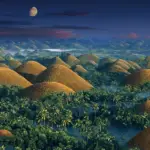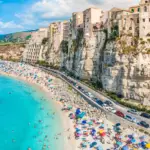
But where are the Galapagos Islands? Galapagos Islands are a natural treasure hidden in the Pacific Ocean, located about 1,000 km off the coast of Ecuador. This archipelago volcanic is known for its rich biodiversity and for being the place where the famous naturalist Charles Darwin developed his theory of evolution.
The islands boast a huge variety of ecosystems, which are home to endemic species and wild animals that cannot be found anywhere else in the world.
If you are looking for a unique and exciting travel destination, Galapagos Islands are the perfect place to leave your mark and enjoy nature in its purest form.
Main Conclusions:
- To the Galapagos Islands are about 1,000 km off the coast of Ecuador
- This archipelago volcanic is known for its rich biodiversity and because it is the place where Charles Darwin developed his theory of evolution
- The islands boast a huge variety of ecosystems, which are home to endemic species and wild animals that cannot be found anywhere else in the world
- A trip to the Galapagos Islands offers a unique and exciting experience of nature in its purest form.
Introduction to the Galapagos Islands
The Galapagos Islands, a archipelago volcanic located in the Pacific Ocean, are a true treasure of biodiversity and an unmissable destination for nature lovers. Despite its location remote, the islands are one of the tourist destinations most popular in the world, attracting visitors from all over the planet in search of unique and unforgettable experiences.
THE location The Galápagos Islands are unique and isolated, located approximately 965 km off the coast of Ecuador. Comprising 19 main islands and numerous islets and rocks, the archipelago is a paradise for marine and terrestrial animals, many of which are endemic and found only on the islands.
The biodiversity of the Galápagos Islands is incredible, boasting over two thousand species of plants, animals, and fish. Many of these species are rare or endangered, making the islands an important center for biodiversity research and conservation.
Geography of the Galapagos Islands
The Galápagos Islands are an archipelago made up of 13 large volcanic islands, 6 smaller islands, and more than 40 islets. Located about 1,000 km off the coast of Ecuador, the islands are known for their unique geography, characterized by a wide variety of volcanoes, climate peculiar and topography diverse.
With a total area of 7,880 km², the Galápagos Islands are home to four inhabited islands: San Cristóbal, Isabela, Santa Cruz, and Floreana. The other islands are protected as national parks and nature reserves, remaining untouched and allowing for the preservation of flora and fauna.
You volcanoes are a striking feature of the islands, with five volcanoes active volcanoes still in activity, including the Wolf volcano on Isabela Island, the highest in the Galapagos Islands, at 1,707 meters above sea level.
THE climate The Galápagos Islands are influenced by the Pacific Ocean and equatorial ocean currents, resulting in an average temperature of 25°C throughout the year. The region is also famous for its strong winds, known as the "Galapagos winds."
THE topography The islands' landscape is varied, with white sand beaches, rock formations, steep cliffs, caves, lagoons, plains, forests, and mangroves. This diverse landscape is one of the factors that make the Galápagos Islands a tourist destination unique and attractive for nature lovers and adventurers looking for an authentic nature experience.

Flora and Fauna of the Galapagos Islands
The Galapagos Islands are a renowned natural paradise, teeming with endemic species, unique features, and animals found nowhere else in the world. The flora and fauna that inhabit these islands are the main reasons why the Galápagos are so special.
One of the emblematic animals of the Galapagos Islands are the giant turtles, which can live for over a hundred years and weigh up to 400 kg. There are several different species of turtles on the islands, each adapted to a specific environment. giant turtles are one of the main species that attract the attention of tourists and scientists who visit the Galapagos.
Another famous endemic species of the Galapagos Islands are the marine iguanas, which are the only iguanas in the world capable of swimming and feeding in the ocean. They are abundant on the islands and can be seen sunning themselves on the rocks and diving into the crystal-clear sea. The islands are also home to land iguanas and a wide variety of small, colorful iguanas.
The Galápagos Islands are home to enormous species diversity, with over 2,900 plant species, 400 fish species, 33 shark species, and 70 bird species. Many of these species are endemic, meaning they can only be found on the islands. This is a result of the archipelago's geographic isolation, which has allowed unique species to develop and others to adapt to a unique environment.
Endemic species of the Galapagos Islands
| Name | Description |
|---|---|
| Pinzón Giant Tortoise | One of the species of giant turtles that inhabit the islands; there are less than 1,000 individuals remaining. |
| Galapagos Land Iguana | A species of land iguana that can only be found on Santa Fe Island. |
| Darwin's Finches | A group of 13 bird species known for their differences in beak shape, which adapt to different types of food. |
The Galápagos Islands offer a unique opportunity for visitors to marvel at the region's incredible biodiversity. It's important to remember that environmental preservation is essential for the maintenance of endemic species, and therefore, sustainable tourism is essential to ensure the survival of the islands and their natural inhabitants.

Exploring the Galapagos Islands
Visiting the Galapagos Islands is a unique and exciting experience, but it's important to do so responsibly and sustainably. Fortunately, there are many options. tourism sustainable available to those who wish explore these wonderful islands.
One of the main activities that visitors can enjoy in the Galapagos Islands is the diveWith crystal-clear waters and rich marine life, the islands offer a stunning setting for those who want to explore the depths of the ocean. There are many tour companies dive that offer tours of the region, including some that focus on preserving marine life and the environment.
Another popular way to explore the Galapagos Islands is by trail. There are many trails Available for hiking, from short walks to more challenging climbs. Visitors may have the chance to see endemic animals such as land iguanas and the famous "Darwin's finches."
Additionally, tourists can also participate in activities such as boat tours, bird watching, and nature photography. Many companies offer customized tour options, allowing visitors to select their own activities that interest them most.
Regardless of the activity chosen, it is essential that visitors respect nature and minimize their environmental impact. This means following the guidelines of the national park, not interfere with wildlife and ensure that all rubbish is taken off the island.

Conservation and Preservation of the Galapagos Islands
The Galápagos Islands are a unique natural sanctuary, with incredibly diverse ecosystems and unique species inhabiting the region. To preserve these treasures and ensure they are enjoyed by future generations, conservation and preservation measures are essential. National park of the Galapagos Islands is one of the region's leading conservation initiatives, created in 1959 to protect the endangered species of extinction that inhabit the islands.
THE National park It covers over 971 TP3T of the archipelago's land area, including all islands, islets, and maritime areas within 40 nautical miles of the islands. The reserve is managed by the Government of Ecuador and has a dedicated team of rangers and researchers working to protect and preserve the natural environment of the Galápagos Islands.
Several species native to the Galápagos Islands have been classified as endangered, primarily due to human activity and the introduction of invasive species. These include the pink iguana, the saddleback tortoise, and the Galápagos owl. To help protect these species, the National park of the Galápagos Islands has implemented restocking plans, visitation restrictions, and actions to control the introduction of invasive species.
In addition to the National park, the search scientific is a vital part of the conservation of the Galápagos Islands. Since the naturalist's famous expedition Charles Darwin, in 1835, the region has been a natural laboratory for scientists and researchers. Today, scientific research is conducted throughout the region, including studies on the impact of climate change, shark ecology, conservation of endangered species and much more.
In short, conservation and preservation of the Galápagos Islands are essential to ensuring the survival of the region's unique species and maintaining the integrity of the islands' natural environment. National park of the Galapagos Islands and the scientific research are two great initiatives that demonstrate the commitment to preserving the islands and make the sustainable tourism in the region possible.
History of the Galapagos Islands
The Galapagos Islands are world famous for being the place that inspired the theory of evolution by Charles Darwin. In 1835, Darwin arrived in the archipelago during a five-year expedition aboard the ship HMS Beagle. The naturalist was captivated by the incredible diversity of endemic species that inhabited the islands, many of which were found nowhere else in the world.
It was on the Galápagos Islands that Darwin developed his theory of natural selection, which argued that species best adapted to their environment were more likely to survive and reproduce. He observed this firsthand while studying giant tortoises, whose different shell shapes allowed them to adapt to the specific environmental conditions of each island.
After returning to England, Darwin continued to work on his theory and in 1859 published his book “On the Origin of Species,” which forever changed the way we understand nature and biology.
Since Darwin's visit, many other explorers, scientists, and famous figures have visited the Galápagos Islands, including British naturalist David Attenborough and legendary explorer Jacques Cousteau. Today, the islands are a popular tourist destination and an important center for scientific research.

Galapagos beyond the Islands
If you think the wonders of the Galapagos Islands are limited to just its islands, think again. With cruises and packages tourist attractions, you can explore even more this stunning region and discover experiences immersive unique.
Marvel at the beauty of the crystal-clear waters of the Galapagos Islands on a cruise to observe the most fascinating marine creatures. These cruises offer comfortable accommodations and incredible activities, such as dive on reefs and visits to isolated beaches.
Furthermore, the tour packages They can also take you to incredible places off the islands, like the El Chato Forest Reserve, where you can see giant tortoises in their natural habitat. Or try a hike up the sierra, where you can enjoy panoramic views of the islands.
If you want an even more immersive experience, consider staying in an eco-friendly hotel on one of the smaller islands. Enjoy the exotic landscape and enjoy all the islands have to offer.
Regardless of the type of experience you choose, venture beyond the islands to discover the beauty and diversity that the Galapagos Islands have to offer!
Tips for a Trip to the Galapagos Islands
Planning a trip to the Galapagos Islands can be an exciting experience, but it requires a bit of thought. planning. Here are some essential tips to help you prepare before embarking on this unforgettable journey.
Best Times to Visit
The Galápagos Islands can be visited year-round, but the best time to visit depends on the activities planned. Peak season runs from June to September, when temperatures are cooler and the water is colder, making it ideal for those looking to see sharks, whales, and penguins. December to May is warmer and the best time for diving and birdwatching.
Required Documentation
Foreign visitors must have a valid passport and a tourist visa to enter the Galapagos Islands. Brazilian citizens can stay in the Galapagos Islands for up to 90 days without a visa. Be sure to check entry requirements in advance and have all necessary documents ready before your trip.
Advance Planning
The Galapagos Islands are a popular destination, so it's important to book your accommodations, activities, and excursions in advance. Make sure to book your reservations a few weeks or months in advance, especially if you plan to visit during peak season.
Essential Items
Some essential items to bring to the Galapagos Islands include sunscreen, a hat, sunglasses, insect repellent, and comfortable clothing for hiking and outdoor activities. It's also important to bring cash, as some shops and restaurants don't accept credit cards.
Sustainable Tourism
The Galapagos Islands are a World Heritage Site, and as such, it's important to practice sustainable tourism. Be sure to follow the rules established by the Galapagos Islands National Park and avoid littering. trails or beaches, not touching wild animals and supporting local conservation initiatives.
With these tips in mind, you're ready to plan your trip to the Galapagos Islands and enjoy one of the most fascinating adventures of your life.

Conclusion
Complete your journey by exploring the Galapagos Islands, a true paradise hidden on the map, but found and kept in the heart. Whether you're a nature lover or an adventure-seeking traveler, the Galapagos Islands offer a unique and unforgettable experience.
Awaken your adventurous spirit and be enchanted by the natural wonders of this unique place. With a rich and varied biodiversity, the Galápagos Islands are home to unique and fascinating species, such as the iconic giant tortoises and marine iguanas.
Furthermore, sustainable tourism allows you to explore the islands in a conscious way, participating in activities such as diving and trails. And, at the same time, contribute to the conservation and preservation of the islands' ecosystem.
When you visit the Galápagos Islands, you'll also be immersed in history and science. Charles Darwin visited the islands on his famous voyage aboard the Beagle, developing his theory of evolution. Today, the region is a major center for scientific research.
When planning your trip, remember to consider the best times to visit and the documentation necessary. And to experience all that the Galapagos Islands have to offer, choose tour packages that allow complete immersion in this incredible place.
Awaken your adventurous spirit and embark on a unforgettable journey in the Galapagos Islands. A true natural treasure, ready to be explored by you.
FAQ
Q: Where are the Galapagos Islands?
A: The Galapagos Islands are located in the Pacific Ocean, about 1,000 km off the coast of Ecuador.
Q: What is the biodiversity of the Galapagos Islands?
A: The Galapagos Islands are known for harboring unique biodiversity, with many endemic species, including giant tortoises, marine iguanas and a variety of birds.
Q: What are the geographic features of the Galapagos Islands?
A: The Galapagos Islands are a volcanic archipelago, with active volcanoes, climate tropical and a topography varied that includes beaches, forests and mountains.
Q: What are some of the flora and fauna found in the Galapagos Islands?
A: In addition to giant tortoises and marine iguanas, the Galapagos Islands are home to a variety of endemic plants, such as the Opuntia cactus, and animals such as sea lions, penguins, albatrosses, and many other species.
Q: What are the sustainable tourism options in the Galapagos Islands?
A: In the Galapagos Islands, you can enjoy activities such as diving, hiking, and boat tours, all of which focus on preserving the environment and respecting wildlife.
Q: What are the conservation and preservation efforts in the Galapagos Islands?
A: The Galapagos Islands are protected by the National park of the Galápagos Islands and are a UNESCO Biosphere Reserve. Furthermore, the region is the target of ongoing scientific research to improve conservation. endangered species.
Q: What is the historical significance of the Galapagos Islands?
A: The Galapagos Islands are world-famous for having been visited by Charles Darwin, who developed his theory of evolution based on observations made on the islands.
Q: How can I explore the Galapagos Islands beyond the islands?
A: One of the ways to explore the Galapagos Islands beyond the islands is through cruises and tour packages that offer immersive experiences, allowing you to discover different islands and make the most of your trip.
Q: What are some important tips for planning a trip to the Galapagos Islands?
A: It is important to plan ahead, consider the best times to visit the islands, get the documentation necessary, as well as being aware of the rules and regulations to protect the wildlife and environment of the Galapagos Islands.
Lucas Wanderlust has a tireless spirit of adventure, always seeking new travel experiences. Fascinated by the world and the possibility of exploring unknown destinations, he fell in love with the sense of freedom and self-discovery that traveling alone provides. With a backpack on his back and a heart open to the unknown, Lucas embarks on exciting journeys, where each destination becomes a unique chapter in his life story. He gives himself body and soul to the magic of solo travel, inspiring others to follow in his footsteps and discover themselves through adventure.







